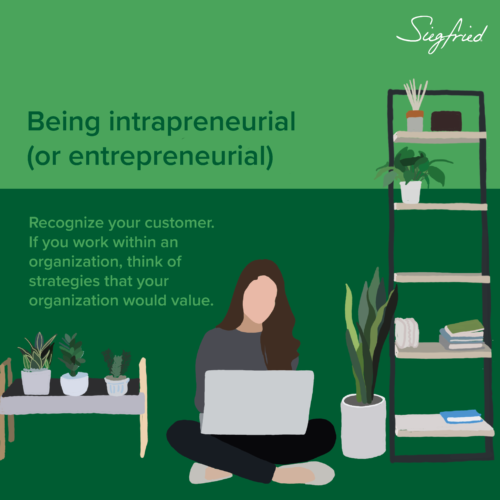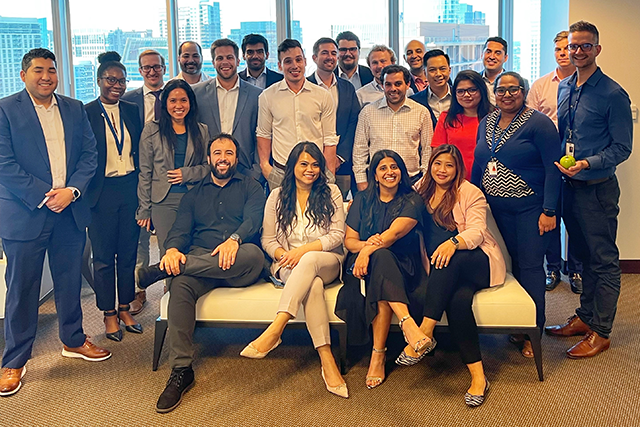We all want to do what we love, or at least love what we do.
And it’s possible, according to Kaihan Krippendorf, the most recent winner of the Siegfried Award for Entrepreneurial Leadership. “My passion is strategy, but my purpose is really people loving what they do.”
By utilizing the strategies of what Kaihan called an “outthinker,” you can create impact that empowers you to do what you love by finding innovative, unique solutions.
Finding the fourth option
The idea of the outthinker strategy is to improve your adaptive ability in a purpose-driven world. To best create impact and enjoyment from being an outthinker, you must practice strategic agility, or the ability to think quickly and differently to find opportunities. This mindset blazes the trail for something Kaihan calls the fourth option, which occurs when your competition stops thinking of new ideas and instead rehashes old methodology to solve problems.
This absence of ideas creates space for you to provide innovation and capitalize on what others aren’t seeing. But Kaihan stresses that it’s not about understanding the nitty-gritty of new technologies or industries. Instead, it’s about understanding the concepts around the technology that present opportunities for change.
There’s been examples of the fourth option throughout history, especially in sports. At the 1968 Olympic Games, Dick Fosbury won gold in the high jump with his backward jump over the bar, lovingly referred to now as the Fosbury Flop. Before this gold medal win, participants would jump over the bar facing forward, but eight years after Fosbury’s gold, more than 90% of high jumpers performed the Fosbury Flop. In fact, it’s a technique that persists to this day.

Being intrapreneurial
Stories like the Fosbury Flop or the garage-to-mansion stories of Amazon and Apple inspire people to think about starting their own venture to find joy and power. But that’s a misconception, says Kaihan.
“My studies have shown that if we look at the most impactful innovations of society, 70% of the most transformative ideas came from employees. Because of individuals acting entrepreneurial in an established company, we now have the internet. You have a cell phone to connect it to. You are able to send an email instantly to almost anyone in the world.”
Bringing entrepreneurial value within the structure of a pre-existing company is called intrapreneurship, and it is just as viable, perhaps even more so, than traditional entrepreneurship.
“Either way, you have a great opportunity to make a difference,” says Kaihan.

Find your opportunity
The first step to becoming an outthinker is, of course, to find a problem worth solving. This is much easier said than done and requires a close understanding of your passions.
“Knowing what your passion is, or what your sense of purpose is, will help you narrow down the universe of market opportunities to isolate those that you would be driven to solve,” shares Kaihan.
If you hold an internal role in a company, this exercise is a little easier, because your customer is already established: the organization you are in! Ask yourself what the organization needs, what their strategy is, and what their priorities and goals are. This forms the framework of how you proceed with generating ideas and, when combined, will present areas for innovation.
If you do not currently have a role within an organization, or plan on going the entrepreneurially route, this can be a little tricky, but is ultimately very fulfilling. Once you’ve found your problem, you will need to connect with customers to learn more in-depth about how to best provide your innovative solution. Is it a product or a service? How can you get it in the hands of customers and making a difference, quickly?
The theme here is curiosity: without having the drive to dig deeper and ask questions of the status quo, you won’t be able to disrupt industries ripe for innovation. Ask as many questions as you can, make connections, and try to understand your chosen problem on an intimate level.

Ideate, ideate, ideate
After establishing the framework for your opportunity, move into generating ideas. The trick behind ideation is dedication and volume: by constantly pushing yourself to think of ideas, you’ll invariably create a few worth pursuing.
Kaihan’s ideation strategy revolves around patterns. By finding patterns, you’ll begin to play a long-term game. As Wayne Gretzky said, “Don’t skate to where the puck is, skate to where the puck will be.” This strategy of playing a long-term game based on forecasted consumer and technological progress patterns is perhaps most famously used by Uber, who have built their technological platform for the future development of autonomous fleets, though their app is currently used by human drivers.
But as an individual, within an organization or not, your access to such detailed forecasting reports is most likely minimal. Play the game within your own means and what you have access to, and just as when you were searching for your opportunity, ask questions of everything. Consider all facets of your potential idea, like the target consumer’s beliefs, the feasibility of production or maintenance of a product and service, and so on.
An actionable idea will be born from this exercise of questioning industry assumptions as you learn more about your problem and inch closer to finding an innovative solution.

Map your ideas and capitalize
Once you have a list of ideas, you’ll need to sift through them to determine which are worth pursuing, and which are destined to be abandoned. Kaihan plots his ideas on a graph with four quadrants, weighing each idea through its ease of implementation and its potential impact.
“You define impact the way you want,” explains Kaihan. “It could be fulfillment, it could be revenue, could be profit, it could be value.”
Kaihan calls ideas that are difficult to implement and low-impact “wasted time ideas.” Their only suitable application is a deposit into the trash. The ideas that seem a little crazy, with difficulties around implementation and a potentially high-impact, are the ones worth pursuing.
To make that happen, ask yourself relevant questions about how you can differentiate yourself from your competitors. How can you bring your product or service to market faster? Can you outsource the process to reduce costs? Focus on what your competitors are not, and you’ll be rewarded with innovation.
Once an outthinker…
The outthinker strategy requires you to first know yourself on a deeper level and what you care about. If you’re aligned with and truly understand what your purpose is, you can create the most impact while being the most happy. The outthinker strategy of searching for the fourth option succeeds when you find that near-perfect intersection of added value and personal fulfillment. You’ll create impact not just for your organization, but for your community and for all of your relationships, inspiring others to search for their own fulfillment in a positive, beneficial manner.









